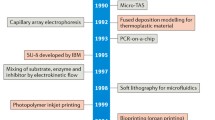Abstract
Biomedical applications—prostheses, tissue engineering, drug delivery, and wound healing—demand increasingly sophisticated characteristics from the materials that come into contact with living systems in the laboratory and the clinic. With the development of microfluidics, there is an opportunity to create active biomaterials based on embedded microfluidic structures. These structures allow for control of the concentrations of soluble chemicals and hydrodynamic stresses within the material and at its interfaces, and thus allow one to tailor the environment experienced by the living tissue. In this article, we review initial efforts to develop these microfluidic biomaterials and present considerations regarding the required characteristics of the materials and of the microfluidic-mediated mass transfer. As specific examples, we present work toward microfluidic control of mass transfer in scaffolds for tissue engineering and in wound dressings.
Similar content being viewed by others
References
T. Boontheekul, H.J. Kong, and D.J. Mooney, Biomaterials 26 (2005) p. 2455.
J.A. Burdick and K.S. Anseth, Biomaterials 23 (2002) p. 4315.
B.D. Ratner and S.J. Bryant, Annu. Rev. Biomed. Eng. 6 (2004) p. 41.
D.J. Beebe, J.S. Moore, Q. Yu, R.H. Liu, M.L. Kraft, B.H. Jo, and C. Devadoss, Proc. Natl. Acad. Science USA 97 (2000) p. 13488.
V.L. Tsang and S.N. Bhatia, Adv. Drug Deliv. Rev. 56 (2004) p. 1635.
J.C. McDonald, M.L. Chabinyc, S.J. Metallo, J.R. Anderson, A.D. Stroock, and G.M. Whitesides, Anal. Chem. 74 (2002) p. 1537.
G.D. Pins, M. Toner, and J.R. Morgan, FASEB J. 14 (2000) p. 593.
M.D. Tang, A.P. Golden, and J. Tien, J. Am. Chem. Soc. 125 (2003) p. 12988.
M. Mayer, J. Yang, I. Gitlin, D.H. Gracias, and G.M. Whitesides, Proteomics 4 (2004) p. 2366.
K.R. King, C.C.J. Wang, M.R. Kaazempur-Mofrad, J.P. Vacanti, and J.T. Borenstein, Adv. Mater. 16 (2004) p. 2007.
D. Therriault, R.F. Shepherd, S.R. White, J.A. Lewis, Adv. Mater. 17 (2005) p. 395.
M. LaBarbera, Science 249 (1990) p. 992.
R.L. Fournier, Basic Transport Phenomena in Biomedical Engineering (Edwards Brothers, Lillington, N.C., 1998).
P. Weisz, Science 179 (1973) p. 433.
C.K. Colton, Cell Transplantation 4 (1995) p. 415.
M. Cabodi, N.W. Choi, J.P. Gleghorn, C.S.D. Lee, L.J. Bonassar, and A.D. Stroock, J. Am. Chem. Soc. 127 (2005) p. 13788.
R. Langer and J. Vacanti, Eds., Principles of Tissue Engineering (Academic Press, San Diego, 2000).
I. Martin, D. Wendt, and M. Heberer, Trends Biotechnol. 22 (2004) p. 80.
J.T. Borenstein, H. Terai, K.R. King, E.J. Weinberg, M.R. Kaazempur-Mofrad, and J.P. Vacanti, Biomed. Microdevices 4 (2002) p. 167.
C. Fidkowski, M.R. Kaazempur-Mofrad, J. Borenstein, J.P. Vacanti, R. Langer, and Y.D. Wang, Tissue Eng. 11 (2005) p. 302.
S.C.N. Chang, J.A. Rowley, G. Tobias, N.G. Genes, A.K. Roy, D.J. Mooney, C.A. Vacanti, and L.J. Bonassar, J. Biomed. Mater. Res. 55 (2001) p. 503.
J.A. Rowley, G. Madlambayan, and D.J. Mooney, Biomaterials 20 (1999) p. 45.
K.V. Lambert, P. Hayes, and M. McCarthy, Eur. J. Vasc. Endovasc. Surg. 29 (2005) p. 219.
M.J. Morykwas and L.C. Argenta, FASEB J. 7 (1993) p. A138.
V. Saxena, C.W. Hwang, S. Huang, Q. Eichbaum, D. Ingber, and D.P. Orgill, Plastic Reconstruct. Surg. 114 (2004) p. 1086.
M. Cabodi, K.L. Havenstrite, V. Curtis, S. Suzanne, and A.D. Stroock, “A Microfluidic Wound Dressing and Wound Analysis Tool,” presented at the ASME Summer Bioengineering Conf. (Vail, Co., June 22–26, 2005).
Q. Liu, E.L. Hedberg, Z. Liu, R. Bahulekar, R.K. Meszlenyi, and A.G. Mikos, Biomaterials 21 (2000) p. 2163.
Rights and permissions
About this article
Cite this article
Stroock, A.D., Cabodi, M. Microfluidic Biomaterials. MRS Bulletin 31, 114–119 (2006). https://doi.org/10.1557/mrs2006.25
Published:
Issue Date:
DOI: https://doi.org/10.1557/mrs2006.25




